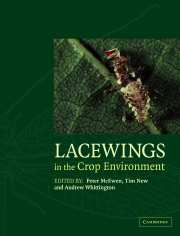Book contents
- Frontmatter
- Contents
- List of contributors
- Preface
- PART 1 Lacewing systematics and ecology
- PART 2 Lacewings in crops
- PART 3 Principles
- PART 4 Case studies
- Introduction to Part 4
- CHAPTER 18 Micromus tasmaniae: a key predator on aphids on field crops on Australasia?
- CHAPTER 19 Preliminary notes on Mallada signatus (Chrysopidae) as a predator in field crops in Australia
- CHAPTER 20 An evaluation of lacewing releases in North America
- CHAPTER 21 Chrysoperla externa and Ceraeochrysa spp.: potential for biological control in the New World tropics and subtropics
- CHAPTER 22 Comparative plant substrate specificity of Iberian Hemerobiidae, Coniopterygidae, and Chrysopidae
- CHAPTER 23 Lacewings in Sardinian olive groves
- CHAPTER 24 Lacewing occurrence in the agricultural landscape of Pianura Padana
- CHAPTER 25 Lacewings and snake-flies in Piedmont vineyards (northwestern Italy)
- CHAPTER 26 Control of aphids by Chrysoperla carnea on strawberry in Italy
- CHAPTER 27 Artificial overwintering chambers for Chrysoperla carnea and their application in pest control
- CHAPTER 28 Lacewings in Andalusian olive orchards
- CHAPTER 29 The green lacewings of Romania, their ecological patterns and occurrence in some agricultural crops
- CHAPTER 30 Biological control with Chrysoperla lucasina against Aphis fabae on artichoke in Brittany (France)
- PART 5 Conclusion
- Taxonomic index
- General index
Introduction to Part 4
Published online by Cambridge University Press: 04 May 2010
- Frontmatter
- Contents
- List of contributors
- Preface
- PART 1 Lacewing systematics and ecology
- PART 2 Lacewings in crops
- PART 3 Principles
- PART 4 Case studies
- Introduction to Part 4
- CHAPTER 18 Micromus tasmaniae: a key predator on aphids on field crops on Australasia?
- CHAPTER 19 Preliminary notes on Mallada signatus (Chrysopidae) as a predator in field crops in Australia
- CHAPTER 20 An evaluation of lacewing releases in North America
- CHAPTER 21 Chrysoperla externa and Ceraeochrysa spp.: potential for biological control in the New World tropics and subtropics
- CHAPTER 22 Comparative plant substrate specificity of Iberian Hemerobiidae, Coniopterygidae, and Chrysopidae
- CHAPTER 23 Lacewings in Sardinian olive groves
- CHAPTER 24 Lacewing occurrence in the agricultural landscape of Pianura Padana
- CHAPTER 25 Lacewings and snake-flies in Piedmont vineyards (northwestern Italy)
- CHAPTER 26 Control of aphids by Chrysoperla carnea on strawberry in Italy
- CHAPTER 27 Artificial overwintering chambers for Chrysoperla carnea and their application in pest control
- CHAPTER 28 Lacewings in Andalusian olive orchards
- CHAPTER 29 The green lacewings of Romania, their ecological patterns and occurrence in some agricultural crops
- CHAPTER 30 Biological control with Chrysoperla lucasina against Aphis fabae on artichoke in Brittany (France)
- PART 5 Conclusion
- Taxonomic index
- General index
Summary
We have deliberately devoted a large section of this book to descriptions of lacewing assemblages and practical examples of the use and manipulation of lacewings in pest control programmes. This allows the reader to evaluate lacewings in action and we hope that it will promote the greater use of lacewings in pest control in the future. We have attempted to provide some geographical balance to this section by including examples from around the world but despite this the section is heavily Eurocentric with little input from Australasia and the Americas and none at all from Asia and Africa. We know that work on the use of lacewings does occur in these areas particularly in Egypt in North Africa and in China and would hope that future editions of this book would include contributions from these areas.
The section has an inevitable bias towards chrysopids which have received the most attention in pest control programmes and we are therefore particularly pleased to see contributions dealing with Micromus tasmaniae from Australia, and some reporting on other Hemerobiidae and on Coniopterygidae from the Iberian peninsula.
In terms of cropping systems covered we have been somewhat more successful in providing a good variety of case studies. Thus, whilst two chapters deal with lacewings in olive groves we also have contributions on strawberry pest control, vineyards, a range of Italian ecosystems, and artichokes in France.
The contributions vary greatly in their approach with some chapters giving specific release rates of lacewings in different cropping systems, and others dealing with more specific potential ways of improving lacewing performance by, for example, conservation of overwintering populations.
Information
- Type
- Chapter
- Information
- Lacewings in the Crop Environment , pp. 387Publisher: Cambridge University PressPrint publication year: 2001
